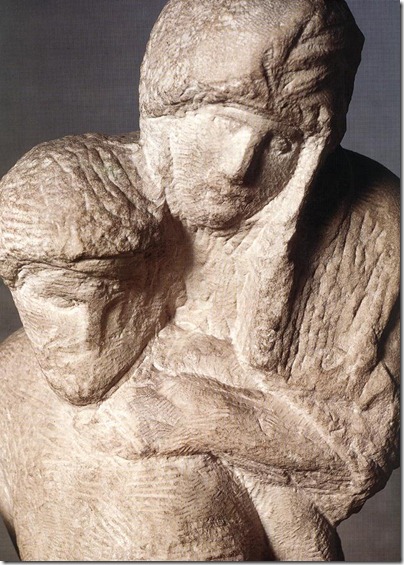Michelangelo’s Pietà Rondanini Moves Home Posted by Serena on Nov 30, 2012 in News
A few days ago, while browsing through the newspaper ‘Corriere della Sera’, I came across an interesting article about Michelangelo’s last sculpture, la Pietà Rondanini. Michelangelo is thought to have started working on this Pietà (pietà is the name used for a representation of the Virgin Mary mourning over the dead body of Christ) in 1552, but sometime around 1555 he changed the original design, traces of which are still visible in Jesus’ right arm, which is detached from the rest of the sculpture (see photo), and his perfectly finished legs. The artist also changed the direction of the Virgin’s face, as we can see from the outline of her eye and nose on the left side of her face. The new composition assumed an unusual standing position in which the two figures of Jesus and Mary seem to mould into one in a moving embrace. Michelangelo was still working on this last masterpiece a few days before his death in 1564.
On the left you can see Christ’s right arm detached from the body
Throughout the centuries the sculpture changed hands several times, one of the owners being the Rondanini family, which explains the name of the artwork. It was finally bought by the City of Milano in 1952. During the Fifties the layout of the City’s museums, hosted within the Castello Sforzesco, was redesigned by a group of architects for the post-war reopening in 1956. The architects decided to isolate Michelangelo’s sculpture in a special area at the end of the route through the Museum of Ancient Art, believing that it gave it more impact. The Pietà was positioned at the bottom of a steep staircase, and surrounded on three sides by a screen. The problem is that this arrangement doesn’t invite the visitor to walk around la Pietà, and makes it impossible for a person with mobility difficulties to access it. This fact was brought to the attention of the Museum and the City Council by, amongst others, Franco Bomprezzi, journalist of the Corriere della Sera, who is himself disabled.
A close up of the faces of Christ and the Virgin Mary
So, after a lot of discussion, it has finally been decided to move the statue to a new, more accessible, location. In order to respect the architects’ original idea of creating a strong visual impact, la Pietà Rondanini will be placed in a vast empty space known as l’Ospedale Spagnolo (the Spanish Hospital), situated in another wing of the castle. L’Ospedale Spagnolo dates back to the 16th century, contemporary with Michelangelo’s sculpture, and was used as a lazaretto (a hospital used to isolate the infected) during la Peste (the Plague). Gli appestati (those infected by the plague) were isolated in this place as they awaited their death.
A few weeks ago Franco Bomprezzi was invited by Milan City Council to visit l’Ospedale Spagnolo to give his approval. Here is his description of the setting: “questa enorme sala è affascinante e dolorosa, si avverte quasi fisicamente la presenza antica del dolore e della morte. Una luce soffusa e dolce attutisce l’angoscia, ma crea sacralità attorno al punto nel quale sarà collocata la Pietà.” (This enormous hall is fascinating and painful, you can almost physically feel the ancient presence of pain and death. A sweet suffused light softens the anguish, but creates a sense of the sacred at the point where the Pietà will be placed).
Whilst the Spanish Hospital is undergoing its restoration, Michelangelo’s Pietà will be temporarily moved to San Vittore, Milan’s star shaped prison, and placed right in the centre, from where the six arms of the building radiate. It will become a symbol of suffering and the hope for redemption.
I’m looking forward to seeing Michelangelo’s wonderful sculpture in its new surroundings, because unfortunately I don’t have a pleasant memory of it from my last visit to the Castello Sforzesco many years ago. I didn’t have any sense of strong visual impact when I saw la Pietà Rondanini, but rather a feeling of coldness and distance created by that industrial looking cement screen that surrounds it. And this is a shame because I particularly love this work of art, as I do all of Michelangelo’s so called “unfinished” sculptures. I have the sensation that they are struggling to free themselves from the inert stone that imprisons them.

Build vocabulary, practice pronunciation, and more with Transparent Language Online. Available anytime, anywhere, on any device.






Comments:
Daniel Ellar:
I still remember from my two visits (’79 & ’90) to the Castello Sforzesco the sensation of coolness associated with the Pieta’s surroundings, and welcome the planned new environment.
Serena:
@Daniel Ellar Salve Daniel!
Ho appena letto sul giornale che i lavori per la nuova sede della Pieta’ Rondanini sono cominciati. Speriamo che facciano presto!
Saluti da Serena